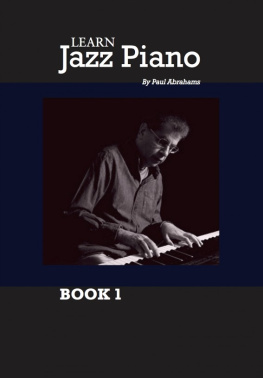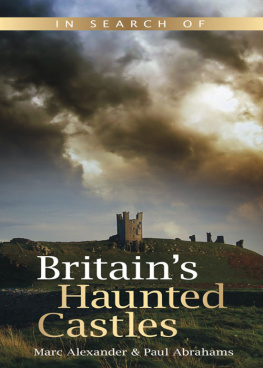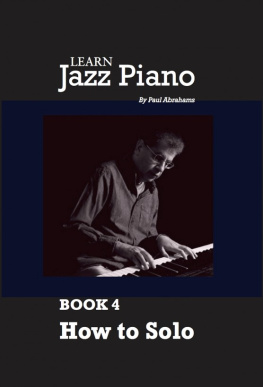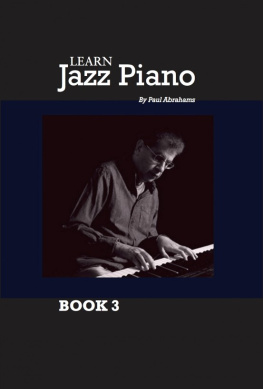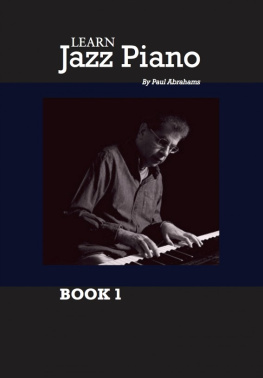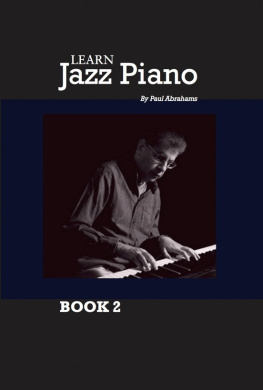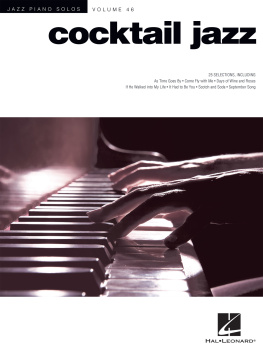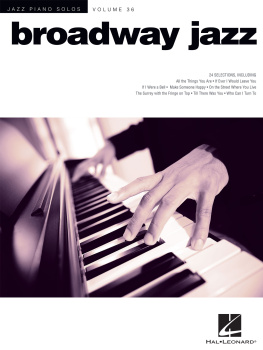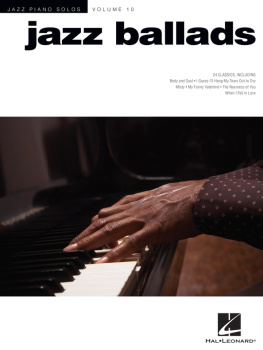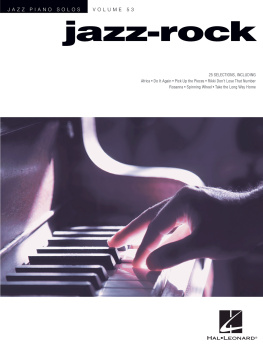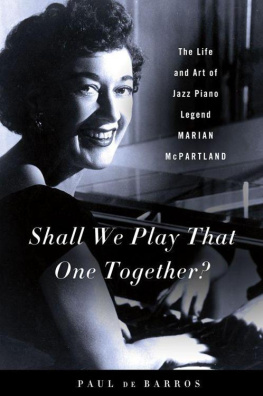Paul Abrahams - Learn Jazz Piano Book 1
Here you can read online Paul Abrahams - Learn Jazz Piano Book 1 full text of the book (entire story) in english for free. Download pdf and epub, get meaning, cover and reviews about this ebook. publisher: Paul Abrahams, genre: Children. Description of the work, (preface) as well as reviews are available. Best literature library LitArk.com created for fans of good reading and offers a wide selection of genres:
Romance novel
Science fiction
Adventure
Detective
Science
History
Home and family
Prose
Art
Politics
Computer
Non-fiction
Religion
Business
Children
Humor
Choose a favorite category and find really read worthwhile books. Enjoy immersion in the world of imagination, feel the emotions of the characters or learn something new for yourself, make an fascinating discovery.
- Book:Learn Jazz Piano Book 1
- Author:
- Publisher:Paul Abrahams
- Genre:
- Rating:3 / 5
- Favourites:Add to favourites
- Your mark:
- 60
- 1
- 2
- 3
- 4
- 5
Learn Jazz Piano Book 1: summary, description and annotation
We offer to read an annotation, description, summary or preface (depends on what the author of the book "Learn Jazz Piano Book 1" wrote himself). If you haven't found the necessary information about the book — write in the comments, we will try to find it.
Learn Jazz Piano Book 1 — read online for free the complete book (whole text) full work
Below is the text of the book, divided by pages. System saving the place of the last page read, allows you to conveniently read the book "Learn Jazz Piano Book 1" online for free, without having to search again every time where you left off. Put a bookmark, and you can go to the page where you finished reading at any time.
Font size:
Interval:
Bookmark:
Published by Paul Abrahamsat Smashwords www.learnjazzpianoonline.com This ebook is licensed foryour personal enjoyment only. This ebook may not be re-sold orgiven away to other people. If you would like to share this bookwith another person, please purchase an additional copy for eachreader. If youre reading this book and did not purchase it, or itwas not purchased for your use only, then please return toSmashwords.com and purchase your own copy.
Thank you for respecting the hard work of this author. Paul Abrahams, 2011 Authors note Although this book can be readindependently, I would recommend that each section is studiedalongside my online video series LearnJazz piano , which can be purchasedhere: Learn Jazz PianoOnline with Paul Abrahams Together with each online video I have bundled fourbacking tracks, downloadable sheet music and a quiz. At the start of each chapter I have indicated whichvideo lesson relates to the text.
This is the first in a seriesof threeLearn Jazz Piano eBooks . A fourth book is entitled How ToSolo . TABLE OFCONTENTS Terminology Forobvious reasons, more Americans than Brits listen to my podcasts.So after numerous emails asking me what I mean by a crotchet, Ivemended my ways and now refer to quarter notes. This also means thatswing quavers are now swing eights. With apologies to my Britishreaders Ill also be using the following terms, which appear in theleft-hand column. Intervals USA / UK half step/semitone whole step /tone Note names USA / UK whole note/semibreve half note/minim quarter note/crotchet eighth note/quaver Naming chord symbols As no two books use the same chord symbol names, Imopting for the following: 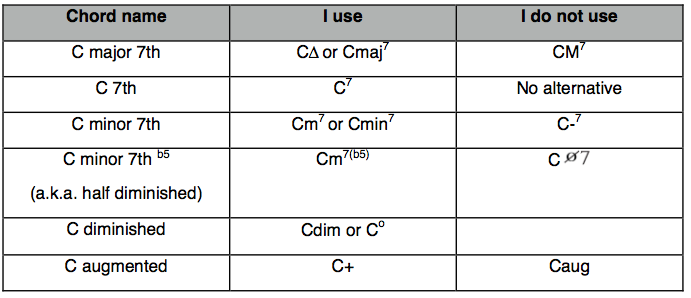 Naming extensions As the name suggests, extensionsare notes played above the octave.
Naming extensions As the name suggests, extensionsare notes played above the octave.
They should therefore bereferred to as 9 ths ,11 ths and 13 ths and their respective flattened or sharpenedversions as b ths , # ths , # ths andb13 ths . 9, 11 and 13 are usually referredto as extensions and b9, #9, #11 and b13 as alterations. In myonline course I occasionally use the term primary extensions for 9,11 and 13 and secondary extensions for #9, #11 and b13. If these added notes occur within a chord theyshould, in theory, be referred to as 2 nds , 4 ths and6 ths etc. Unfortunately, the world isntthat simple and the same note can be described in a number of ways.For example, # 11will often be referred to as b5. Here are thepossibilities: 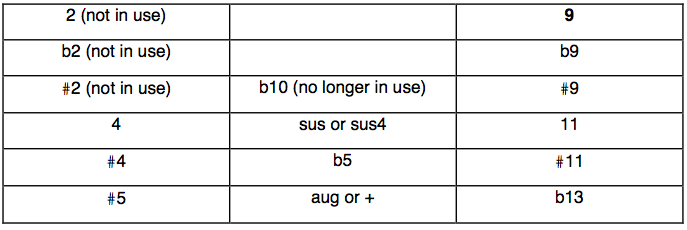 You will also encounter + and -signs instead of # and b.
You will also encounter + and -signs instead of # and b.
The good news is that 9 ths dontchange. If the 5 th is being replacedwithin the chord, then C 7(b5) is used to describethe note G b . If a b13 is also required, then it must also beshown: C 7( b5 # 11) = C + E +G b +B b +F # So, even thoughG b andF # are the same noteenharmonically, they serve different functions and therefore needto be described individually. This also applies to b13 and # Having said that, so many chordcharts use b5 and # 11 (and b13 and # 5) arbitrarily, I suggest that youget used to seeing them as the same note. Glossary Bridge The B section in a song form, usually containing 8 bars.Also known as the middle 8. Comp Thepiano accompaniment to a solo.
Extensions Added notes not within the basic harmony of achord. Head Theoriginal tune before and after the solos. Horizontal improvisation The scale stays constant throughout chordchanges. Interval The space between two notes. Key centre The key connecting a group of related chords. Lead sheet Melody plus chords.
Mode Ascale built from the steps of major or minor scale Rhythm changes Chord changes based on Gershwins IGot Rhythm . Root Pitch 1 of a chord. Standard A well-known tune favored by jazz musicians. Tritone An interval of 3 whole steps Turnaround A chord sequence taking you back to the start or onto thenext section. A common turnaround I - VI - II V . Vertical improvisation Each chord has an influence over the improvisednotes.
Voicing The combination and placement of notes within achord. Walking 3s and 7s Linking the 3 rd or7 th note of each chord. Introduction What isjazz? Even if I had an answer, a betterquestion might be: what was jazz ? Whatever it was through the 20s and 30s, andhow bebop musicians like Charlie Parker changed it forever, nolonger seems relevant. For better or worse, jazz has permeated intoso many other genres that it no longer has a separate identity. Asa teenager I was drawn to soul and R&B. My favorite singer then (and now) was RayCharles.
But was he also playing jazz? Or was it blues? His answerwas that he was playing music. Were John Coltrane and Miles Davisstill playing jazz by the end of their careers? Improvisation wastheir means of further exploration. Jimi Hendrix was doing the samething. Jazz or blues? I have little interest inseparating the two. In most cases, one is a part of the other. Someplayers, such as Wynton Kelly are more influenced by the blues.Others, like Bill Evans are less so.
Even the phrase 12 bar blues ismisleading. It is a sequence in which to improvise: how bluesy or jazzy is up to you. Inthe end, my personal aim is not to play in a particular style butrather to express myself in the moment. It is a communication ofhow I feel. Why all the theory? If jazz musicians just play whatthey feel, why the need to learn scales, modes and all that stuffin the glossary? My simple answer is that any artist needs toacquire technique before discarding it. If you can play on instinctalone, you wont need this book, but the rest of us require toolsto enable creativity.
Nice jazz/nasty jazz I have a friend who will onlylisten to so-called traditional jazz. Anything from Charlie Parker onwards, tohis ears, sounds discordant and incomprehensible. But at what pointdoes nice turn to nasty? Is there some defining musical moment whena sound is perceived as discordant? Take the blues: the blues scaledoes not stand up to analysis; it really shouldnt work. The soundof a flat 3 rd being struck over a major triad would make Mozartturn in his grave. But my friend has no objection to this sound. Itis at the root of Rock &Roll , the music he grew up with.
The soundof a b 9 within a 7 th chord will also go unnoticed. (If this meansnothing to you, all will be explained. It works because the b 9 is part ofthe diminished that travels through a 7 th chord.) But playa sharp 9 and myfriend will make his excuses and leave. What is happening? As wemove further away from the home scale, the sound becomesincreasingly discordant. This is called playing outside. By using theseextensions and alterations we are creating the spice and edginessthat lies at the very heart of jazz (whatever jazz is).
There is,however, a time and place to use these more discordantsounds. The aim By the end of this course, youwill possess a total grasp of chord symbols and see how they relateto scales, modes and extensions. This will enable you to solo andcomp through any jazzstandard . You will also learn the variousforms of a 12 bar blues sequence and gain an understanding of modaljazz. Requirements This course is not aimed at total beginners. Youwill need some basic knowledge of scales and keys plus the abilityto read at least the notes of the treble clef.
If you cant read,it will do you no harm to start learning now! On the other hand,dont be fooled by the seemingly basic level in the early sections.I can assure you there will be some exciting challenges ahead. Purchase video lesson 1 for this chapter. Chapter 1: From Scalesto Chords Without further ado lets start playing! EXERCISE
Next pageFont size:
Interval:
Bookmark:
Similar books «Learn Jazz Piano Book 1»
Look at similar books to Learn Jazz Piano Book 1. We have selected literature similar in name and meaning in the hope of providing readers with more options to find new, interesting, not yet read works.
Discussion, reviews of the book Learn Jazz Piano Book 1 and just readers' own opinions. Leave your comments, write what you think about the work, its meaning or the main characters. Specify what exactly you liked and what you didn't like, and why you think so.

